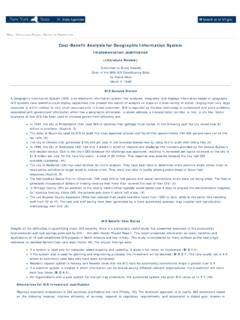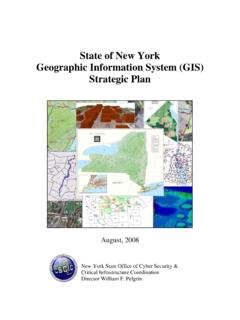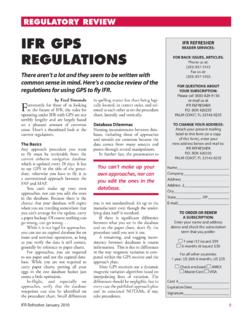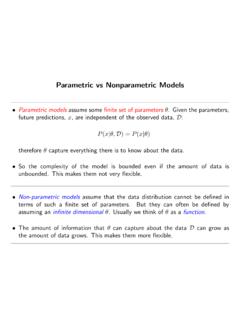Transcription of Glossary of GPS Terminology - Government of New York
1 Glossary of GPS Terminology Autonomous Positioning The least precise form of positioning that a GPS receiver can produce. The position fix is calculated in real time from satellite data alone. Autonomous positions are generally accurate to within 10 meters. Base station A base station is comprised of a GPS antenna and receiver positioned on a known location specifically to collect data for differential correction. Base data needs to be collected at the same time as you collect data with a GPS rover unit. A base station can be a permanent installation that collects base data for provision to multiple users, or a rover unit that you temporarily locate on known coordinates for the duration of a specific project or datalogging session. Carrier Phase The difference between the carrier signal generated by the internal oscillator of a roving GPS receiver and the carrier signal emitted from a particular GPS satellite.
2 Coarse/Acquisition (C/A) Code A pseudorandom noise code (PRN) modulated onto a L1 signal which helps the GPS receiver to compute the distance from each satellite. Specifically, the difference between the pseudorandom number code generated by the GPS rover software and the pseudorandom number code coming in from the satellite is used to quickly compute the distance to a satellite and therefore calculate your position. CORS (Continuously Operating Reference) Station A network of GPS base stations coordinated by the National Geodetic Survey for the purpose of providing GPS reference data to permit end users to perform post-processed differential correction of GPS data collected with roving receivers. Reference data is typically acquired via direct download from the Internet. Data Dictionary A term used to describe the schema, or structure, that defines the relationship between features and their descriptive attributes that will be located in the field with a professional GPS receive.
3 This description typically includes feature name(s), data type classification (point, line, or area), attribute names, attribute types, and attribute values. After being created on a PC, a data dictionary is transferred to a GPS datalogger and used when collecting data in the field. Data Message A message included in the GPS signal, which reports a satellite's location, clock correction, and health. It includes information on other satellites' health and their approximate positions. NYS Office of Cyber Security & Critical Infrastructure Coordination 30 South Pearl Street, Albany, NY 12207. Phone: 518-474-5212 Fax: 518-473-5848. Datum A datum is a mathematical model of the earth's surface. World geodetic datums are typically defined by the size and shape of an ellipsoid and the relationship between the center of the ellipsoid and the center of the earth.
4 Because the earth is not a perfect ellipsoid, any single datum will provide a better model in some locations than others. Therefore, various datums have been established to suit particular regions. For example, maps in the United States are often based on the North American datum of 1927. (NAD-27) or 1983 (NAD-83). All GPS coordinates are based on the WGS-84 datum surface. Datum Transformation A datum transformation is a mathematical calculation that converts the coordinates of a position in one datum to coordinates in terms of another datum. Two types of datum transformations are supported by most professional grade GPS data collection and management software: three-parameter and seven- parameter. A datum transformation is used when the GPS results are required in terms of a local datum. Declination See magnetic declination.
5 Differential Correction Differential correction is the process of correcting GPS data collected on a rover with data collected simultaneously at a base station. Because it is on a known location, any errors in data collected at the base station can be measured, and the necessary corrections applied to the rover data. Differential correction can be done in real time, or after the data has been collected by post processing. Dilution of Precision (DOP). An indicator of the quality of a GPS position, which takes account of each satellite's location relative to the other satellites in the constellation, and their geometry in relation to the GPS receiver. A low DOP. value indicates a higher probability of accuracy. Standard DOPs for GPS applications are: PDOP Position (three coordinates). HDOP Horizontal (two horizontal coordinates).
6 VDOP Vertical (height only). TDOP Time (clock offset only). Dual-frequency Receiver A type of receiver that uses both L1 and L2 signals from GPS satellites. A dual-frequency receiver can compute more precise position fixes over longer distances and under more adverse conditions by compensating for ionospheric delays. Earth Centered, Earth Fixed (ECEF). A Cartesian coordinate system used by the WGS-84 reference frame. The center of the system is at the earth's center of mass. The z axis is coincident with the mean rotational axis of the earth, the x axis passes through 0 N and 0 E, the y axis is perpendicular to the plane of the x and z axes. NYS Office of Cyber Security & Critical Infrastructure Coordination 30 South Pearl Street, Albany, NY 12207. Phone: 518-474-5212 Fax: 518-473-5848. EGNOS (European Geostationary Navigation Overlay Service).
7 A satellite-based augmentation system (SBAS) that provides a free-to-air differential correction service for GPS users in Europe. EGNOS is the European equivalent of WAAS, which is available in the United States. Elevation Mask See Minimum elevation. Ellipsoid An ellipsoid is the three-dimensional shape that is used as the basis for mathematically modeling the earth's surface. The ellipsoid is defined by the lengths of the minor and major axes. The earth's minor axis is the polar axis and the major axis is the equatorial axis. Ephemeris The current satellite position predictions that are transmitted from a GPS satellite in the NAVDATA. message. Epoch The measurement interval of a GPS receiver. Global Positioning System (GPS). GPS is the generic term used to describe the satellite-based timing and positioning system operated by the United States Department of Defense (DoD).
8 Height Above Ellipsoid (HAE). HAE is a method for referencing altitude. Altitudes expressed in HAE are actually giving the height above the datum, not the ellipsoid. GPS uses the WGS-84 datum and all heights are collected in relation to this surface. It is important to use the same datum when comparing altitudes in HAE. Horizon The line at which the earth and sky seem to meet for any particular observer. Horizontal Dilution of Precision (HDOP). See DOP. L1. The primary L-band carrier used by GPS satellites to transmit satellite data. The frequency is MHz. It is modulated by C/A code, P-code and a 50 bit/second navigation message. L2. The secondary L-band carrier used by GPS satellites to transmit satellite data. The frequency is MHz. It is modulated by P-code and a 50 bit/second navigation message. NYS Office of Cyber Security & Critical Infrastructure Coordination 30 South Pearl Street, Albany, NY 12207.
9 Phone: 518-474-5212 Fax: 518-473-5848. Latitude Latitude is an angular measurement made from the center of the earth to north or south of the equator. It comprises the north/south component of the latitude/longitude coordinate system, which is used in GPS data collection. Traditionally, north is considered positive, and south is considered negative. Longitude Longitude is an angular measurement made from the center of the earth to the east or west of the Greenwich meridian (London, England). It comprises the east/west component of the latitude/longitude coordinate system, which is used in GPS data collection. Traditionally, east is considered positive, and west is considered negative. Magnetic Declination Magnetic declination is the difference between magnetic north and true north. Declination is expressed as an angle and differs between locations.
10 Magnetic North A bearing that is relative to magnetic north uses the north magnetic pole as its north reference. Map Projection A defined method of transforming positions defined on an ellipsoid to a map grid; for example, the Transverse Mercator and Parallel Lambert projections. Maximum PDOP The highest PDOP value at which a receiver will compute positions. Mean Sea Level (MSL). Mean Sea Level is a method of altitude reference. Altitudes expressed in relation to MSL actually give a height above the geoid. It is important to use the same geoid when comparing altitudes in MSL. Minimum Elevation The angle above and relative to the horizon, below which your GPS rover will not track satellites. It is normally set to 15 to avoid interference problems caused by buildings and trees and multipath errors. Multipath Interference, similar to ghosts on a television screen, which occurs when GPS signals arrive at an antenna after traversing different paths.






